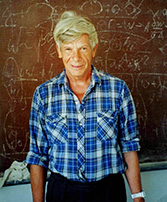Speaker
Description
The mystery of the nature of dark matter is one of the most
interesting problems of modern theoretical physics. The lack of
progress in attempts to directly detect dark matter allows us to
assume that all effects related to dark matter are purely
gravitational. The key idea of such an approach is to switch from GR
to some modified theory of gravity with more general equations than
the Einstein equations. If new equations can be written as Einstein
equations with an additional contribution in the r.h.s., then some of
the degrees of freedom of the modified gravity appear to be
responsible for dark matter which turns out to be fictitious. The
comparison of the properties of this fictitious matter arising in
considered modified gravity with the observable properties of dark
matter gives the opportunity to verify the theory. The most known
example of such modified gravity is the mimetic gravity. However, the
mimetic gravity in its simplest form leads to fictitious matter with a
too small number of degrees of freedom. In order to describe all
observable properties of dark matter the mimetic gravity should be
significantly complexified by introducing additional parameters and
terms into the action of the theory. Another example of an appropriate
modified theory of gravity is Regge-Teitelboim's embedding theory
giving essentially nontrivial fictitious matter right away. On the
other hand, the description of gravity in terms of embedding theory
has a clear geometric sense closely related to the one utilized in the
fundamentals of the string theory. The key idea of the embedding
approach is to suggest that the time-space is a curved 4-dimensional
surface in a flat 10-dimensional ambient space. Since the usual
Einstein-Hilbert action is used the embedding gravity doesn't contain
any additional parameters. The properties of the fictitious matter in
this approach can be compared with the observed properties of dark
matter on the cosmological and galactic scales as well. For the
convenience of comparison, one can reformulate the embedding gravity
in a form of GR with additional contributions at the level of choice
of action and degrees of freedom. Also, a method can be proposed to
analytically estimate the possibility of core or cusp density profile
origin in galaxies in order to gather more precise information about
dark matter behavior.

